Physical Address
304 North Cardinal St.
Dorchester Center, MA 02124
Acknowledgments: I would like to acknowledge Greg Merrell, MD, and Hill Hastings, MD, for their extremely comprehensive chapter in the previous edition of this text. Their masterful work required some minor editing and the addition of updates, which are included in this edition.
This chapter will cover ligamentous injuries of the digits and thumb focusing on acute and chronic dislocations of the proximal interphalangeal (PIP), distal interphalangeal (DIP), interphalangeal (IP), and metacarpophalangeal (MCP) joints of the thumb and digits and the carpometacarpal (CMC) joint of the thumb. The focus will be on the anatomy, pathology, clinical evaluation, and preferred treatment options for these common injuries.
Proximal Interphalangeal Joint
The PIP joint is a hinge joint with stability derived from the bony articular contours, collateral ligaments, and volar plate. Slight asymmetry of the condyles imparts up to 9 degrees of supination through the complete arc of PIP motion.
The radial and ulnar collateral ligaments arise from a concave fossa on the outer aspect of each condyle and pass obliquely and volarly to their insertions. The collateral ligaments have proper and volar accessory components. They are anatomically confluent but distinguished by their points of insertion. The proper collateral ligament, which has both a dorsal and a volar component, inserts on the volar third of the base of the middle phalanx, whereas the accessory collateral inserts on the volar plate. The collateral ligaments are the primary restraints to radial and ulnar deviation at the joint.
The volar plate forms the floor of the joint and is suspended on each side by the collateral ligaments. The thick fibrocartilaginous distal portion inserts across the volar base of the middle phalanx. This insertion is only densely attached at its radial and ulnar margins, where it is confluent with the insertion of the collateral ligament. It is thinner centrally and blends with the volar periosteum of the middle phalanx. Radially and ulnarly, the proximal part of the volar plate thickens to form a pair of checkrein ligaments. The checkrein ligaments originate from the periosteum of the proximal phalanx, just inside the walls of the second annular (A2) pulley at its distal margin, and are confluent with the proximal origins of the first cruciate (C1) pulley. The resulting paired, cordlike structures are the secondary restraints to hyperextension of the joint but permit full flexion, thereby providing remarkable stability with minimum bulk. The volar plate is the primary restraint to hyperextension and a secondary stabilizer against radial and ulnar deviation. This is particular true in PIP extension and when the collateral ligaments are incompetent or torn.
The key to PIP joint stability is this boxlike complex, secured on each side by the collateral ligaments and volarly by the volar plate and volar base of the middle phalanx ( Fig. 8.1 ). This configuration produces a three-dimensional construct that strongly resists PIP displacement. For displacement of the middle phalanx to occur, the ligament-box complex must be disrupted in at least two planes.
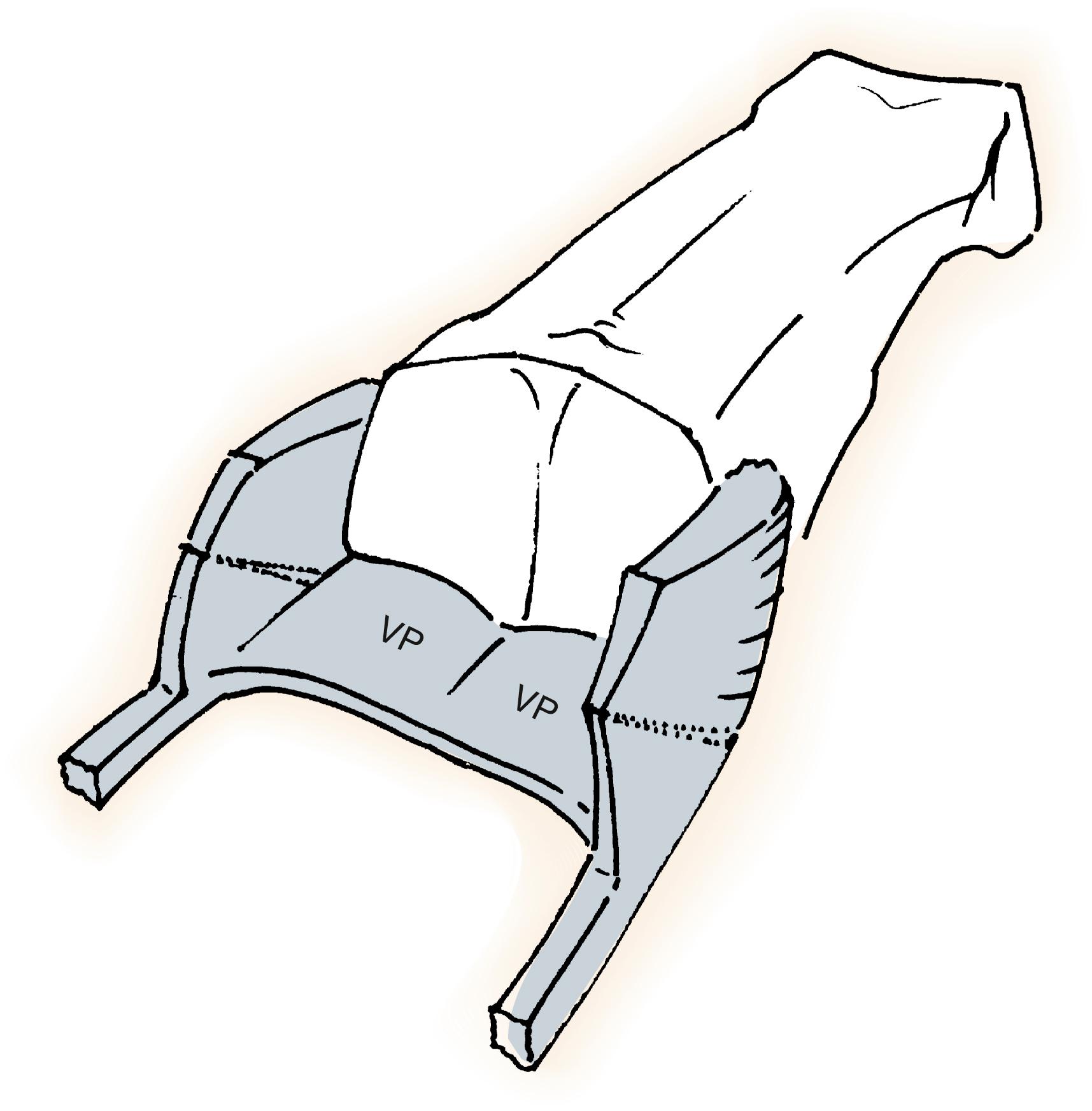
Typically, collateral ligaments fail proximally while the volar plate avulses distally, although variable failure patterns may be encountered.
PIP joint injury is the most common ligamentous injury in the hand. The spectrum of injury can vary from a simple sprain (“jammed finger”) to very challenging fracture-dislocations. Radiographic and clinical evaluation will help differentiate the following differential diagnoses: collateral ligament sprain, volar plate avulsion, central slip disruption, dislocations (which may include disruptions of collateral ligaments, the volar plate, or both), fracture-dislocations, and impacted pilon-type injuries.
Dedicated posteroanterior and true lateral radiographs of the digit or magnified views of the joint itself must be obtained to determine whether recent or preexisting articular involvement is present. Radiographs of the hand alone are not adequate. A subtle fracture or subluxation may otherwise be missed. Keep in mind that the joint may have spontaneously reduced, masking the pathologic situation of a dislocation. Look for the “V” sign dorsally to identify subtlety incongruent or dorsally subluxated joints ( Fig. 8.2 ). These are commonly missed injuries. Pronated and supinated oblique radiographs may also be helpful in identifying fractures at the base of the middle phalanx.
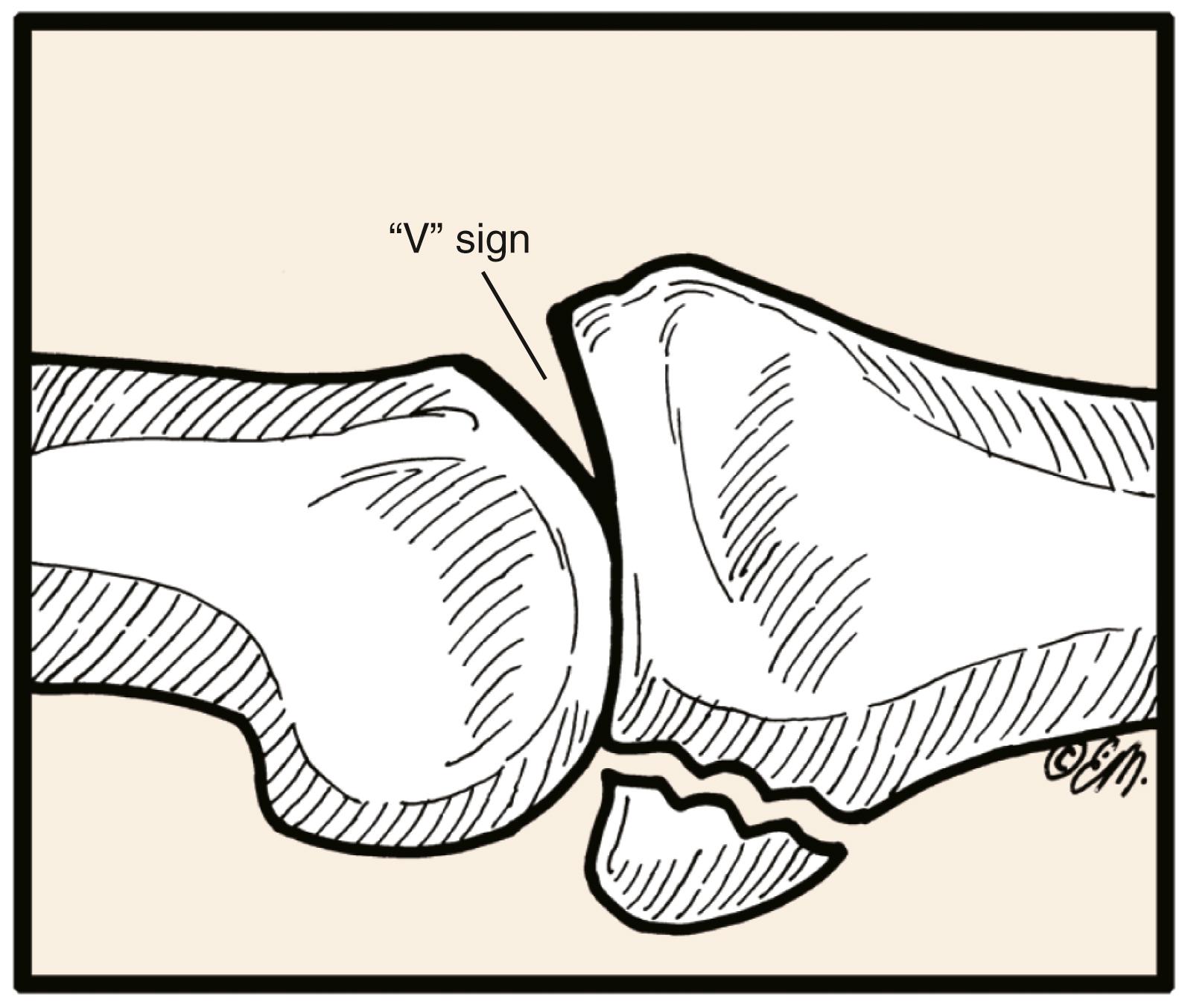
The ultimate determinant of treatment is whether the joint remains concentrically reduced with active motion. This requires adequate pain control from a digital block. Functional stability may be determined by the following two-phase test, after a nerve block.
Active stability. The patient voluntarily moves the digit through its normal range of motion. Completion of a full or nearly full range indicates that, despite ligament disruption, adequate joint stability remains. Redisplacement with motion, however, indicates significant ligament disruption (i.e., at least two sides of the “box”). The position at which displacement occurs is a clue to the specific site of ligament injury, as well as the optimum position for joint reduction and immobilization.
Passive stability. The secondary assessment of stability is determined by passive manipulation. Examine the uninjured side first to establish the baseline level of ligamentous laxity in the patient. Gentle radial and ulnar stresses are applied to each collateral ligament in full extension and 30 degrees of flexion. The flexion examination tests primarily the proper collateral ligaments. The examination in extension gives an indication of the secondary stability afforded by the bony anatomy, accessory collateral ligaments, and volar plate. Sagittal joint stability is tested by shearing the joint surfaces dorsally and volarly.
Collateral ligament injury with the corresponding stability is classified into three grades:
Grade I: Pain, but no laxity
Grade II: Some laxity, but a firm endpoint and stable arc of motion
Grade III: Gross instability; no firm endpoint
The PIP joint may dislocate in one of three directions: dorsal, lateral, or volar. The terms refer to the position of the middle phalanx with respect to the proximal phalanx.
The mechanism of injury in dorsal dislocations is usually PIP joint hyperextension combined with some degree of longitudinal compression, most frequently exemplified by a ball striking a fingertip. The greater the longitudinal force, the more likely it is that the volar lip of the middle phalanx will be sheared off or impacted, producing a fracture-dislocation. In a pure dislocation, the collateral ligaments are torn, but after reduction they remain functionally intact whereas the volar plate is sheared off the base of the middle phalanx. A small avulsion fracture of the base of the middle phalanx is common with dorsal dislocations (44% in one series of 57 hyperextension dislocations) and does not change the diagnosis or treatment.
A simple dorsal dislocation presents in one of two ways: A type I injury is a hyperextension deformity with joint surfaces still touching, and a type II injury is consistent with the phalanges found in a bayonet position. Type III injuries are fracture-dislocations and are discussed later in this chapter.
The hyperextension deformity typically reduces very easily with longitudinal traction, and a small amount of force directed volarly and into flexion after a digital block. In a bayonet dislocation, after digital block, extension stress should be applied to the middle phalanx, and the examiner’s thumb is used to hook the base of the middle phalanx back over the head of the proximal phalanx. If pure longitudinal traction is used, it may trap the condyles by the collateral ligaments and pull the volar plate into the joint, turning a reducible dislocation into an irreducible dislocation. The stability examination, as described previously, is performed after reduction. If the joint is stable through a full range of motion, immediate motion should be encouraged with protection via buddy taping. Stiffness from prolonged immobilization is the most common complication from treating these injuries, and prolonged immobilization should be avoided.
If the joint is unstable, it is placed in an extension block splint at 10 degrees more flexion than the point at which it begins to subluxate. Each week the splint is extended 10 degrees. The goal is to have patients out of splints by 3 weeks or sooner. A cadaveric study suggests that extension block splinting in slight flexion reliably places the avulsed volar plate in a nearly anatomic position to facilitate healing. If the digit requires flexion past 30 degrees to maintain congruency and stability, operative stabilization should be considered. Patients should be counseled to expect persistent pain, swelling, and stiffness for at least 6 months because recovery is typically prolonged.
On rare occasions, the volar plate ruptures from the base of the middle phalanx and may become interposed between the head of the proximal phalanx and the base of the middle phalanx. This can result in an irreducible dislocation requiring an open reduction. Open reduction may occasionally be successful through a limited dorsal incision. A dorsal incision of 5 to 10 mm is made between the central slip and the lateral band. The capsule is incised with just enough space to pass a Freer elevator into the joint. The Freer elevator can be used to push the volar plate out of the joint and gently lever the joint into a reduced position. If this works, it will speed recovery and minimize the risk of flexor adhesions. If this fails, the surgeon can approach the joint through a Bruner extensile volar incision, with reflection of the A3 pulley and flexor tendons and extrication of the volar plate. When possible, the volar plate is repaired to provide immediate improvement in stability and prevent reentrapment. Positioning in the immediate postoperative period is dictated by the degree of stability identified intraoperatively.
The critical anatomic lesions in a lateral dislocation of the PIP joint are rupture of one collateral ligament and at least partial avulsion of the volar plate from the middle phalanx. More than 20 degrees of deformity on gentle static lateral testing in extension indicates complete collateral ligament disruption and injury to at least one other secondary stabilizer. This is a major disruption of the three-sided ligamentous box, but with few exceptions the ligaments heal when the joint is reduced and early controlled motion is begun. The joint should be protected with buddy tapes to an adjacent uninjured digit. Irreducible lateral dislocations typically demonstrate interposition of the lateral band and require operative exploration.
Repair of the ruptured collateral ligaments has been frequently reported after PIP dislocations and has been promoted as essential for a lateral dislocation. Most series involve athletes, and it has been suggested that surgery will enable a faster return to sport. Kato and colleagues reported on 11 primary repairs of acute PIP joint collateral ligament tears in athletes and manual laborers. Suture anchors were used in the repair, active motion was initiated at 2 to 3 weeks, and unlimited activities were allowed at 6 weeks. Nevertheless, because the usual sequela of ligament injury of the PIP joint is stiffness and not instability, the surgical trauma of ligament repair may have an adverse effect on the ultimate range of motion after lateral dislocations. Assuming the joint is stable following closed or open reduction, there is no clear evidence that surgical repair of these ligaments is necessary to promote improved long-term stability and range of motion.
Volar dislocations of the PIP joint are rare injuries. The base of the middle phalanx may dislocate volarly without rotation (volar dislocation) or may rotate on one intact collateral ligament so that the opposite side subluxates in a volar direction (volar rotatory subluxation). Appreciating the difference between these two related injuries and identifying them clinically will help ensure the appropriate management.
A typical mechanism of injury involves catching a digit in a clothes dryer that has not stopped spinning. , As the middle phalanx displaces volarly, the proximal phalangeal condyle ruptures through the extensor mechanism, usually between the central slip and the ipsilateral lateral band. The lateral band may entrap the condyle, creating a situation in which traction and joint extension further tighten the noose created between the lateral band and central slip and block reduction.
When a volar dislocation occurs without a rotatory component, the central slip is ruptured. If the dislocation is irreducible, there is a high likelihood of an interposed structure such as the central slip, a collateral ligament, or a fracture fragment. Puckering of the surrounding skin is suggestive of a joint that still has soft tissue interposed within the joint. If the joint reduces easily, one must still be wary of a central slip disruption, and the ability to actively and fully extend the PIP joint must be confirmed. The Elson test is useful to assess the integrity of the central slip. This test is performed by asking the patient to flex the PIP joint over the edge of the table. Then, against the resistance of the examiner, the PIP joint should be actively extended. The examiner then tests the suppleness of the DIP joint during attempted PIP extension. If the DIP joint is firmly extended or hyperextended, this is indicative that the central slip is incompetent and that all of the active extension force has bypassed the PIP joint and is directed to DIP extension through the intact lateral bands. If the DIP joint is supple, this is consistent with balance between the intact central slip and the lateral bands. The test should be repeated on the neighboring or contralateral uninjured digit. If there is any doubt about the integrity of the central slip, immobilization in full PIP extension for 3 to 4 weeks is mandatory, with the DIP free for active flexion exercises.
Volar fracture-dislocations are quite rare. Injuries with a large dorsal fragment off the middle phalangeal base should be treated with open reduction and internal fixation (ORIF) via minifragment lag screw fixation to allow early motion. Open reduction will also permit inspection or repair of the central slip insertion. Tekkis and coworkers reported two such cases with excellent clinical outcomes. Care must be taken to avoid screw extension into the flexor sheath. Dorsal screw head prominence may require later screw removal. Another option is to secure the fragment with a wire loop. Volar fracture-dislocations with smaller fracture fragments but an intact central slip and concentric joint may be splinted in extension for 1 to 3 weeks followed by active range-of-motion exercises.
The management of chronic volar dislocations of the PIP joint is complex and requires the simultaneous surgical correction of an incongruous and contracted joint as well as an incompetent extensor mechanism. There may be degeneration of the articular cartilage; if so, the prospect of restoring normal joint function is greatly diminished. Therefore it is important to recognize a volar PIP joint dislocation at the time of injury and adequately treat the disrupted extensor mechanism. Peimer and colleagues recommended additional repair of the ruptured collateral ligament. In this relatively large series of 15 patients with volar PIP dislocations, inspection at the time of surgery revealed disruption of the extensor mechanism, the volar plate, and one collateral ligament in all patients. In each, the extensor mechanism and collateral ligament were repaired; the joint was pinned in extension for 4 weeks, at which time motion with therapy was begun. Although all patients had painless, stable PIP motion, no patient achieved preinjury PIP motion.
The management of volar rotatory dislocations of the PIP joint is controversial. Volar rotatory dislocation has been described as irreducible or trapped by many authors and one that necessitates open reduction. , , If one attempt at closed reduction is not successful, I do not recommend further attempts, as this may lead to tightening of the “noose” between the central slip and lateral band. In this scenario, open reduction is advocated not only to reduce the interposed extensor mechanism but also to potentially repair the rent in this mechanism. Others have reported that it is necessary to repair the torn ligaments and volar plate as well. However, I believe that open reduction is necessary only if closed reduction fails and ligament repair is typically not necessary unless joint stability is not achieved following the reduction.
The reduction may be done with a digital anesthetic block. The majority of volar rotatory dislocations may be reduced without surgery by applying gentle traction while holding both of the MP and PIP joints flexed. This maneuver relaxes the volar-displaced lateral band so that with a gentle rotatory motion, the intraarticular portion can be disengaged from behind the condyle and reduction accomplished. If necessary, relaxation of the extensor mechanism can be achieved by moderate wrist extension. Once the joint is reduced, active motion is tested. When the joint is reduced, the ligaments are usually restored to their anatomic alignment. Postreduction radiographs should confirm congruous reduction. After reduction of a volar rotatory dislocation, full active extension is usually possible because the contralateral lateral band and at least a portion of the central slip usually remain intact. If the patient cannot actively extend to neutral, the PIP joint should be immobilized in full extension for 4 to 6 weeks, just as one would treat a closed boutonnière deformity. The only indication for open reduction, therefore, would be failure to obtain a completely congruous reduction, confirmed by radiographs, and presumably due to the presence of a ligament, capsule, or extensor mechanism trapped within the joint.
In volar dislocations without a rotatory component, the reduction is easily accomplished under a digital block. Typically, there is a central slip injury. If active extension is not possible, the patient is treated in full PIP extension for 6 weeks, allowing and encouraging active DIP flexion.
Open reduction is approached through a dorsolateral incision on the side of the ligament disruption. The lateral band is atraumatically extricated from the joint and reduction is easily accomplished. With the patient under local or wrist block anesthesia, it is possible to test active extension. If the lateral band is torn but not severely traumatized, it may be carefully repaired. Should the band be ragged, it is acceptable to excise it because the normal contralateral lateral band is sufficient to provide intrinsic extensor power. If full extension and a stable joint are demonstrable on examination, active range of motion can be initiated. Repair of the extensor mechanism would require a zone 3 tendon repair protocol (see Chapter 5 ). I avoid pinning of the joint if the reduction and/or soft tissue repair provides adequate stability.
The literature contains only a few case reports and results vary substantially, but an 80-degree arc of motion with a 10-degree extensor lag is a reasonable expectation.
There are two fundamental parameters that guide treatment of these injuries: stability and joint congruity. These parameters are the basis for the treatment algorithm seen in Fig. 8.3 .
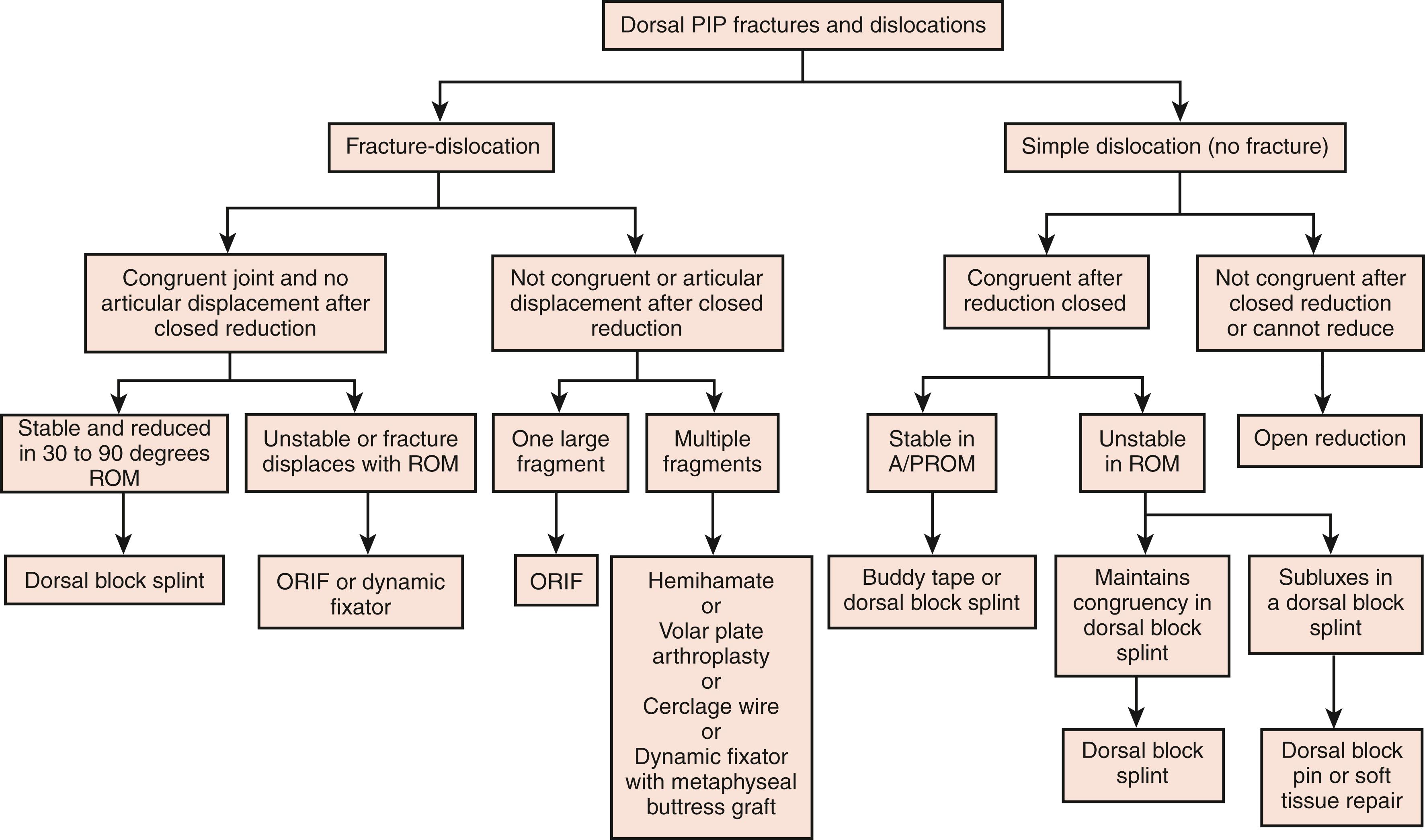
Stable fracture-dislocations have a volar fragment that represents less than 30% of the volar articular surface and a concentric joint after reduction. In this case the disruption occurs through the base of the phalanx rather than at the insertion of the volar plate. Sufficient articular surface of the middle phalanx remains to render the joint stable. The collateral ligaments, if intact, do not influence the sagittal stability of the reduction, but contribute radial/ulnar stability on stress. It is important to check both active and passive motion because the volar fracture fragment may become trapped within the flexor sheath and inhibit motion. Radiographs tend to underestimate the percentage of volar fracture involvement, as frequently the fracture will involve a greater amount of one middle phalanx articular facet than the other. Fluoroscopy after a digital block can help determine how much extension is possible while fracture and joint reduction is maintained. Stable fracture-dislocations may generally be treated nonoperatively, as these usually behave like a simple dorsal dislocation. Injuries with questionable stability may be augmented with 3 weeks of dorsal block splinting, allowing full flexion exercises within the splint. Many patients will require formal hand therapy to regain full motion and function.
Tenuously stable fracture-dislocations involve 30% to 60% of the volar buttress and reduce with less than 30 degrees of flexion. In cases with less than 40% of volar articular involvement, the joint is usually stable in all positions. With 40% to 60% volar articular involvement, progressively greater flexion is required to render the joint stable.
Unstable fracture-dislocations demonstrate greater than 60% involvement of the volar articular surface. Beyond 60% involvement, joints tend to be unstable in all positions or require more than 60 degrees of flexion to obtain a congruent reduction. Accurate closed reduction is difficult to achieve and even more difficult to maintain. The main element contributing to instability is the loss of the buttressing effect of the volar margin of the middle phalanx that partially cups the proximal phalangeal condyles ( Fig. 8.4 ).
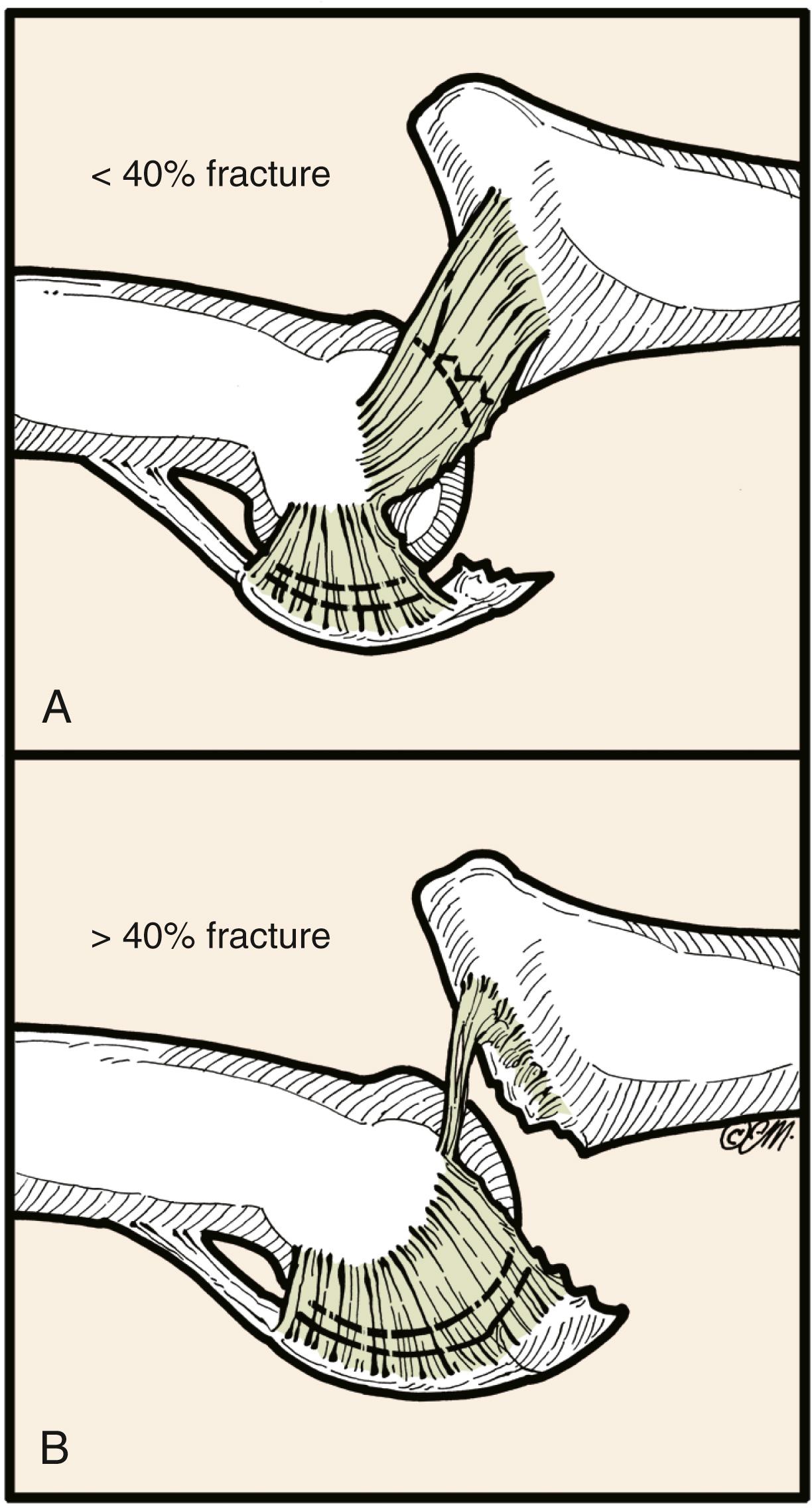
When a high-energy axial compressive force is delivered to a fully extended digit, a pilon fracture of the PIP joint may occur. There is often widening of the base of the middle phalanx as dorsal and volar fragments are driven apart and more central cartilage surfaces are impacted into the cancellous bone.
Depression of the concave articular fossae of the middle phalangeal base mimics certain tibial plateau fractures. Angular deformities are common, especially if only one facet is involved ( Fig. 8.5 ). These fractures may often be subtle on plain radiographs of the involved digit, and the clinician should maintain a low threshold for obtaining a computed tomography (CT) scan of the PIP joint to better visualize the articular depression. Operative reduction is usually necessary, and excellent results are difficult to achieve.
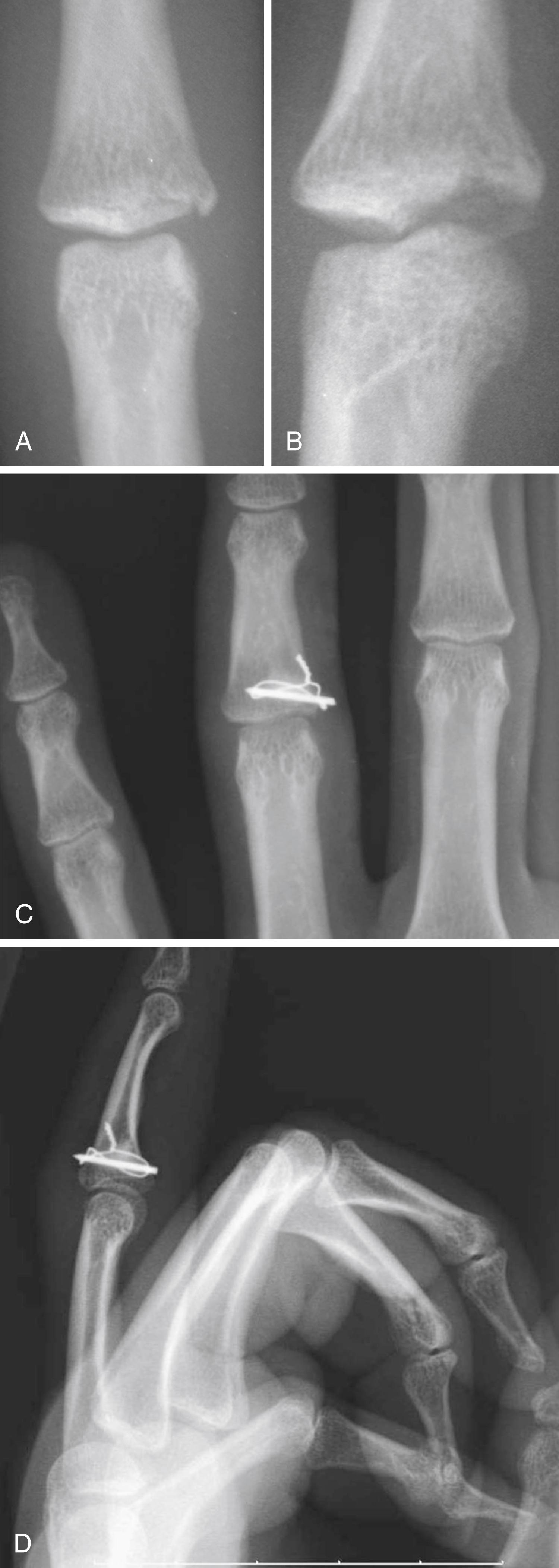
Unstable PIP fracture-dislocations and PIP pilon fractures are some of the most challenging injuries treated by hand surgeons. Patients should be counseled about the severity of the injury and the likelihood of residual stiffness and arthritis because they often consider a “broken finger” to be a relatively minor injury from which they will recover completely. There are a variety of treatments described because no single technique has demonstrated clear superiority. The techniques of extension block splinting or pinning, ORIF, dynamic traction, hemihamate autogenous grafting, cerclage wiring, hemiarthroplasty, and volar plate arthroplasty may all be technically difficult, and each may be appropriate for different types of cases. Detailed step-by-step guidelines follow for each of these techniques.
Closed treatment is recommended if there is no articular incongruity, there is some retained radial/ulnar stability, and the joint is stable with no more than a 30-degree extension block. These conditions are more important than the size of the fracture fragment, although the fragment typically represents less than 40% of the articular surface ( Fig. 8.6 ). McElfresh and colleagues reported good results with active flexion using a dorsal splint to block extension beyond the point of potential redisplacement. The PIP joint is brought into extension incrementally by modifying the splint 10 to 15 degrees per week. However, in their series of 17 fingers, only four patients had a fragment size greater than 30% of the articular surface. Hamer and Quinton prospectively followed 27 patients with fracture-dislocations involving an average of 50% of the articular surface treated by extension block splinting for less than 2 years. They reported a mean of 87 degrees of active PIP motion and good results in 70% of patients. If more than 30 degrees of flexion is required to achieve stability, the risk for late flexion contracture is dramatically increased. In these situations, other treatment options should be considered. Short, small, or very swollen fingers make the fitting of the extension block splint more difficult and may increase the risk of subluxation. Serial radiographs must be obtained to document maintenance of bony alignment when using this labor-intensive technique.
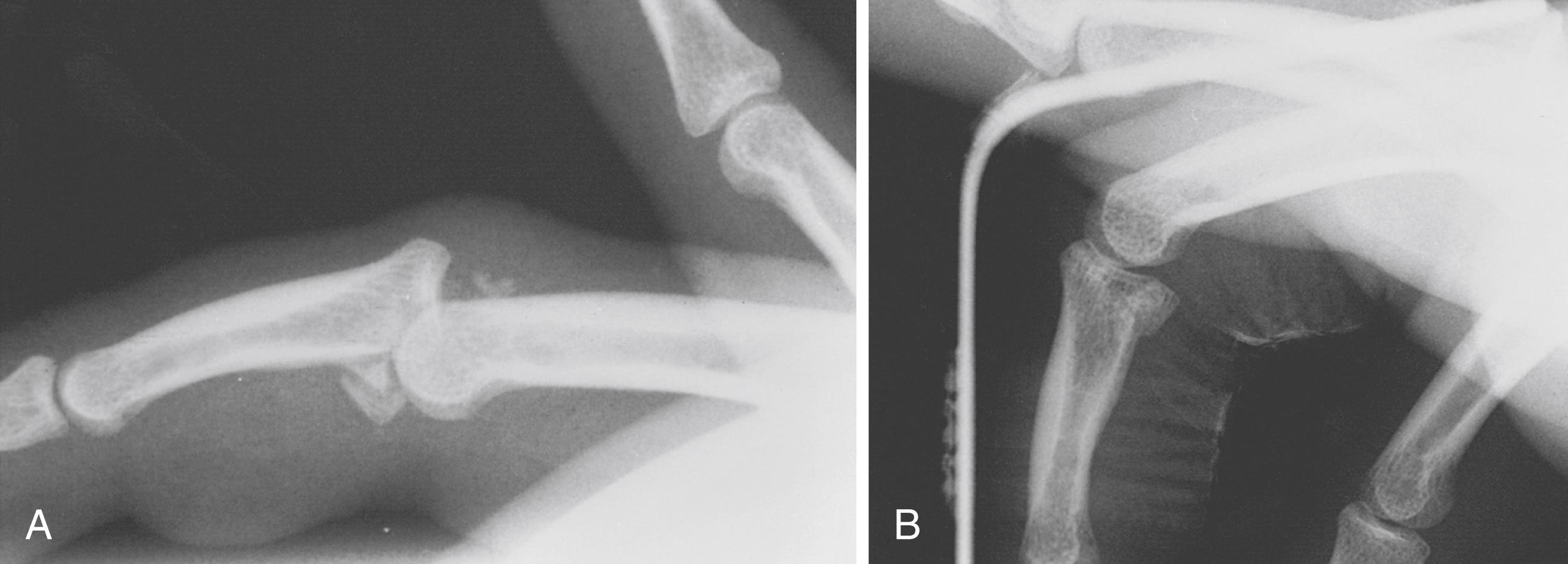
This technique is advocated in rare cases when the injury might be amenable to closed treatment but either the digit is too short and swollen to maintain a splint or there are questions with splint compliance. The technique involves placement of a Kirschner wire into the head of the proximal phalanx at an angle that mechanically blocks extension of the PIP joint and prevents dorsal subluxation of the middle phalanx. The pin must be placed obliquely between the central tendon and lateral bands to allow gentle active motion. Even with a pin in place the joint should be splinted in a single-digit or hand-based splint to decrease the risk for pin migration, loosening, or pin tract infection. Reports of this technique include only a small number of cases, and its clinical efficacy must be substantiated through further study. A modification of this technique has been reported using intramedullary fixation, and the technique has been combined with percutaneous volar pin fixation of the middle phalanx.
This technique refers to the use of ligamentotaxis to achieve joint and fracture reduction by the application of Kirschner wire external fixators or various commercial fixators. We use dynamic skeletal traction most frequently in pilon injuries and in unstable injuries with several small fragments constituting 30% to 100% of the joint surface. When ligamentotaxis is insufficient to achieve an adequate reduction (seen commonly with pilon injuries with depressed fragments), it can be combined with either a limited open reduction or a percutaneous reduction of the joint surface. The fixator can also be combined with volar plate arthroplasty, ORIF, or hemihamate reconstruction to allow earlier active motion with those reconstructions. A fixator helps maintain joint reduction while allowing motion and can neutralize joint reaction forces to minimize the potential for settling of articular fragments that may not be amenable to fixation. A relative contraindication is serious injury to adjacent digits. The fixators can be somewhat cumbersome to wear and can interfere with the care and mobilization of adjacent swollen digits.
Dynamic skeletal traction is useful in select cases, especially with severe comminution and fracture lines extending dorsally (pilon) or distally through the base of the middle phalanx. The fracture is viewed under traction using fluoroscopy to get a sense of the amount of reduction possible and to consider whether the fracture may be more amenable to a different technique ( Fig. 8.7 ). Although many fixators have been described, in the authors’ opinion, the easiest, least expensive, and most effective is a fixator constructed in the operating room using three Kirschner wires and dental rubber bands. , The fixator requires 9-inch double-ended Kirschner wires (check ahead of time because many centers stock only short Kirschner wires). The fixator is assembled by placing two Kirschner wires perpendicular to the digit along the midaxial plane through the proximal and middle phalangeal condyles ( Fig. 8.8 ). It is critical for the initial wire to be placed through the proximal phalangeal condyles, at or near the axis of rotation of the PIP joint. The proximal phalanx wire is bent distally and fashioned into hooks. The second wire is inserted through the middle phalangeal head, at or near the center of rotation of the DIP joint, and this condylar wire is also bent and fashioned into hooks ( Fig. 8.9 ). The distance between the proximal and distal hooks is approximately 2.5 cm ( Fig. 8.10 ), which allows for an adequate but not excessive distraction force by dental rubber bands. Prior to applying the rubber bands, a third midaxial wire is placed in the middle phalanx, which acts as fulcrum, blocking dorsal dislocation of the PIP joint ( Fig. 8.11 ). This third wire is not seen in all publications on the subject but is crucial in unstable pilon-type fractures to provide joint reduction in the sagittal plane without excessive distraction force. Typically, two rubber bands are applied to each set of hooks. Intraoperative fluoroscopy is used to confirm concentric reduction through a full arc of motion ( Fig. 8.12 ), and additional rubber bands are applied as necessary to tailor the distraction. If impacted central fragments remain, one can consider open reduction and bone grafting. Alternatively, an 18-gauge needle or Kirschner wire can be directed fluoroscopically into the fracture site to tamp up the impacted fracture fragment ( Fig. 8.13 ). The patient must be given replacement rubber bands in case of loss or rupture and be seen early and often in the postoperative period for radiographs and monitoring of the amount of traction.
The construct requires long 0.045-inch Kirschner wires; short Kirschner wires are insufficient.
Sterilizable dental rubber bands of 3/8 inch are used.
Less effective if neighboring digits are injured, given width of the construct.
Excellent technique for unstable injuries with comminuted fragments
Careful placement of the proximal phalanx Kirschner wire in the center of rotation of the condyle is needed, as viewed on posteroanterior and lateral radiographs.
Add a third Kirschner wire to prevent dorsal subluxation and minimize the needed distraction force.
Measure 2.5 cm between anchor points for rubber bands on proximal and distal wires.
Confirm motion and reduction in flexion and extension (it helps to advise the hand therapist).
Do not overdistract.
Give the patient extra rubber bands to take home in case some break.
Patient dedication is required in the rehabilitation process.
Assess reduction and degree of traction with radiographs weekly for 2 to 3 weeks.

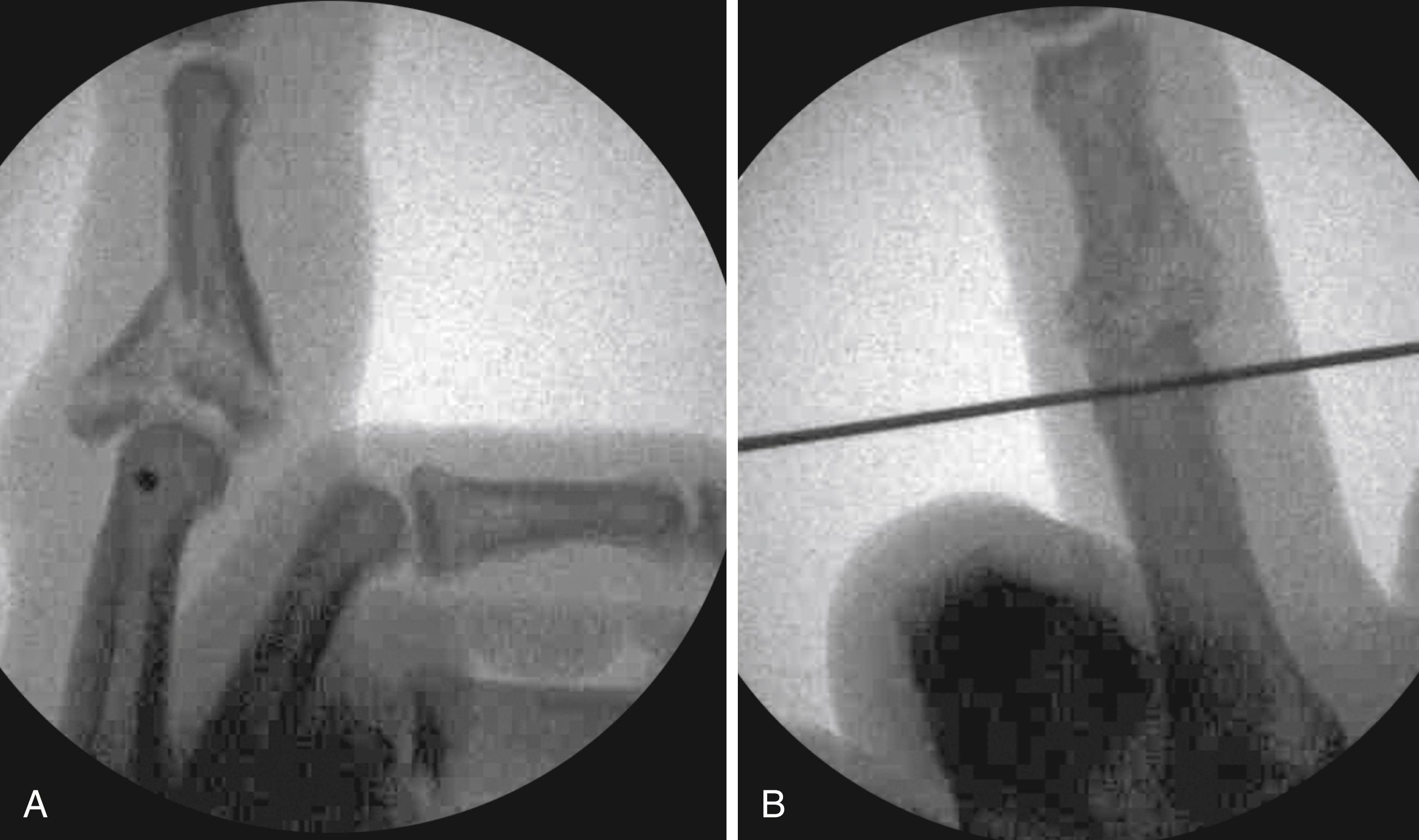
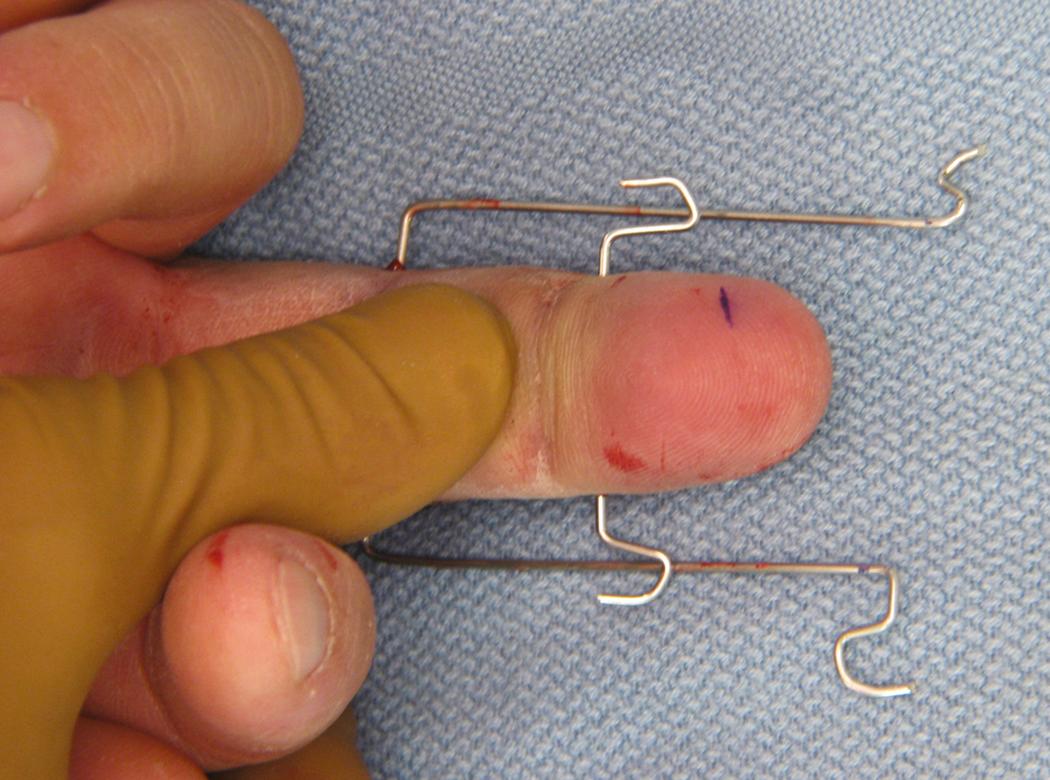
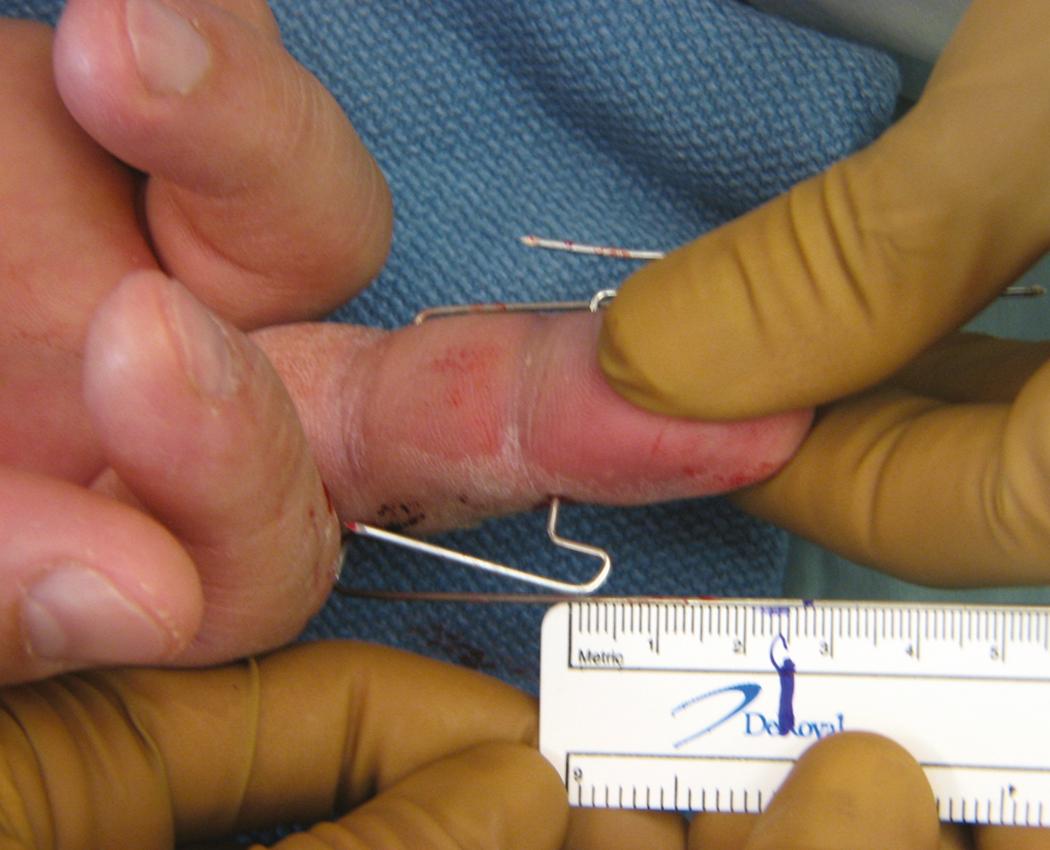
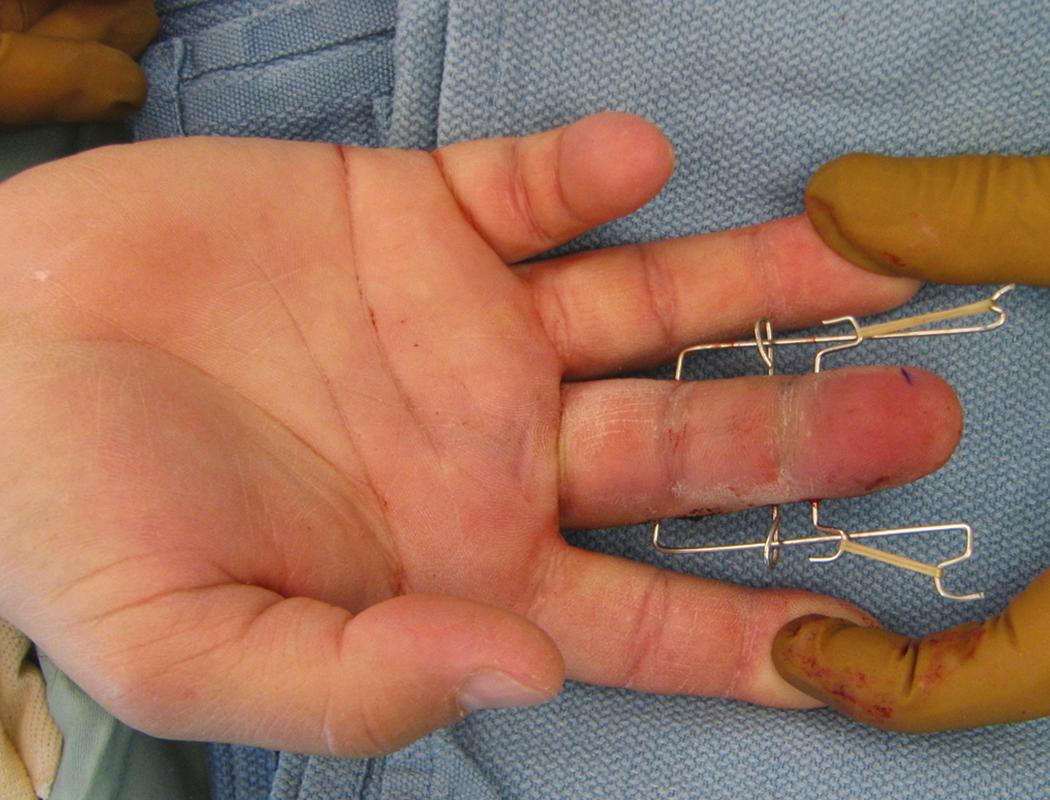
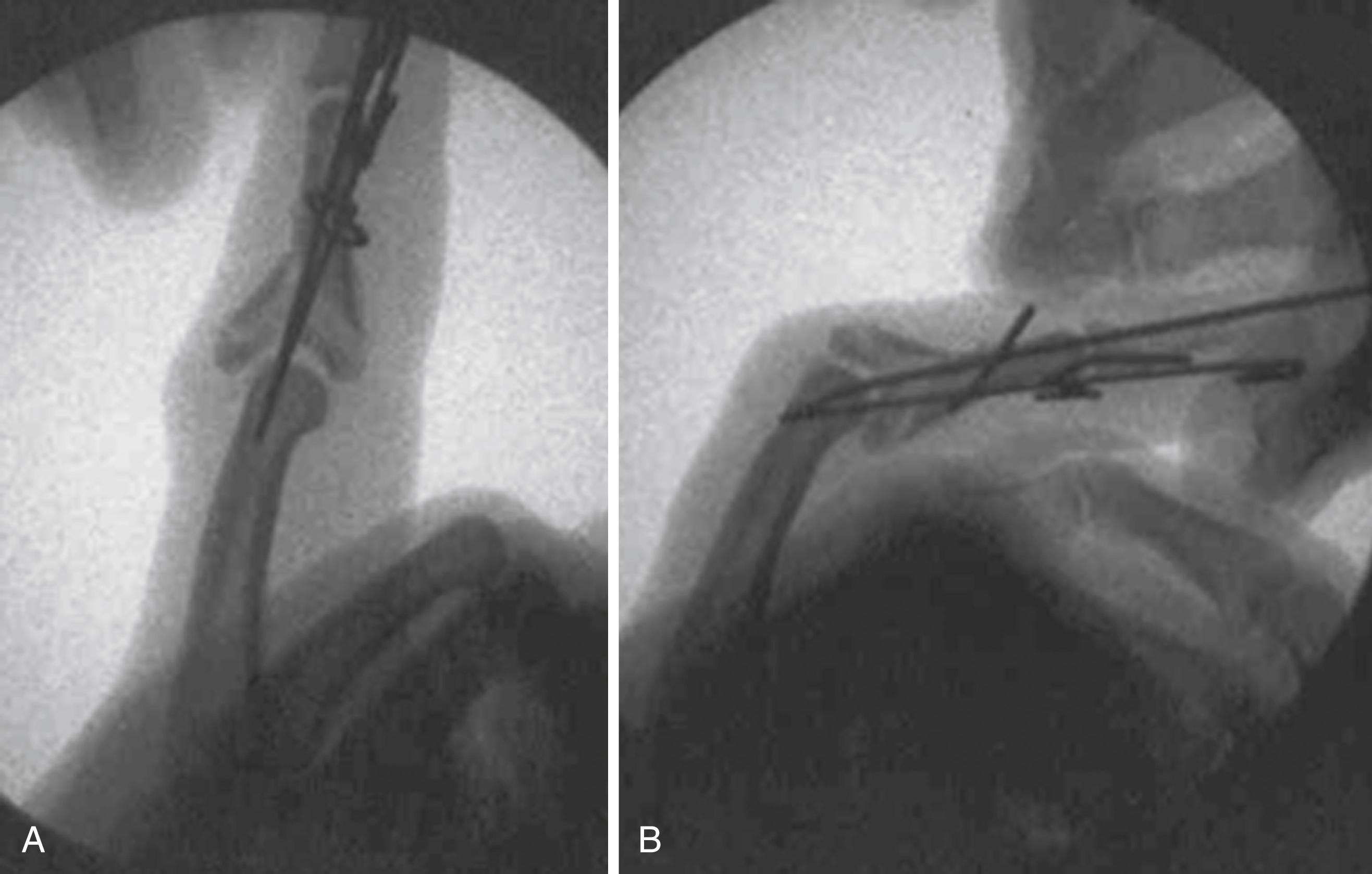
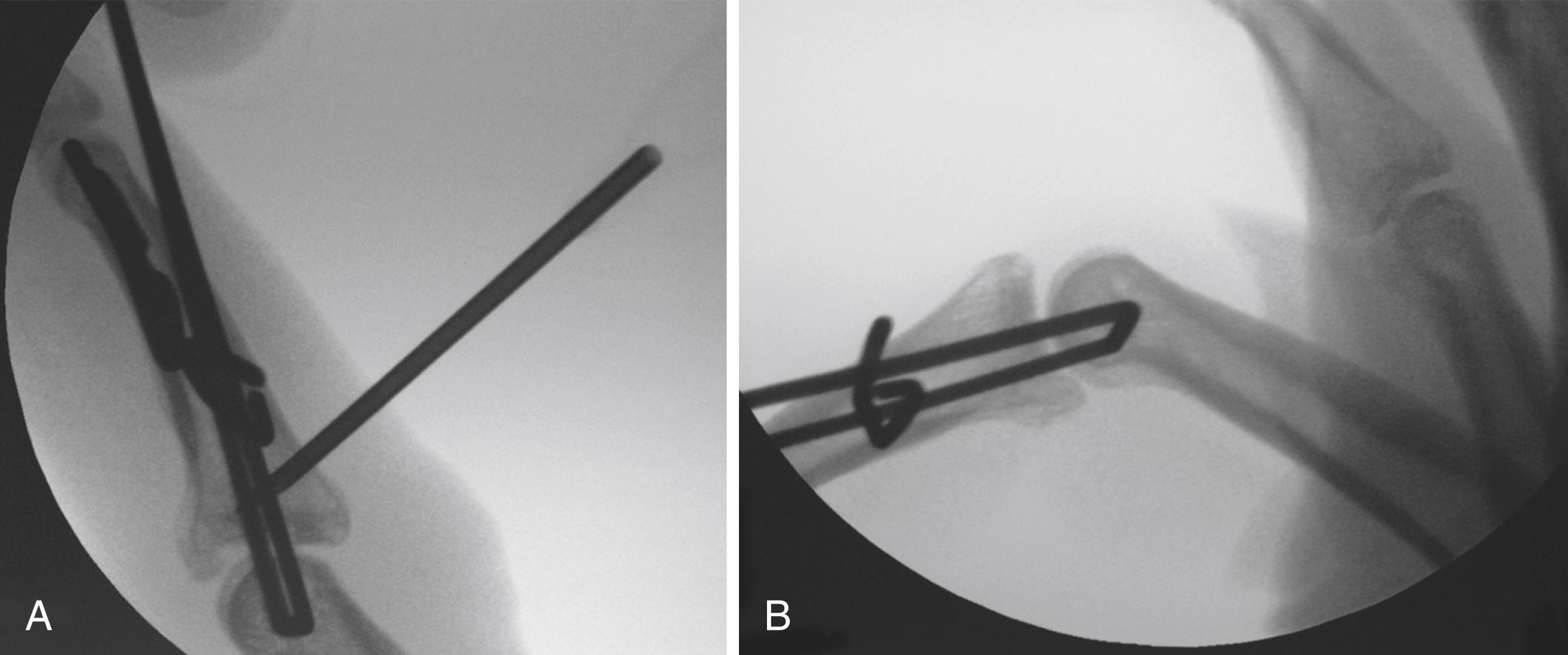
Patients are instructed to elevate and rest the hand for 2 to 3 days to decrease swelling before beginning hand therapy. Patients are permitted both active and passive range of motion as tolerated. Postoperative motion with the fixator in place is typically less than what was demonstrated in the operating room. Pins are swabbed with half-strength peroxide for the first week twice a day and thereafter only if they have drainage. Patients are permitted to get the fixator wet in the shower once wounds are sealed and benign in appearance. Pin tract redness, swelling, or drainage is treated with antibiotics and rest. Radiographs are taken at 1 and 2 weeks to ensure that fracture and joint reduction are maintained and that the joint is not overdistracted. Distraction can be adjusted with rubber band application or removal as indicated by radiographs; ideally, the joint should be only minimally distracted compared with neighboring PIP joints. After 4 weeks, adequate healing is confirmed by removing the dental rubber bands and obtaining lateral radiographs of the digit in flexion and extension. Fixator removal as early as 3 weeks has been reported with successful results. If there is evidence of fracture healing and the joint stays congruent, the fixator is removed; otherwise, it is rechecked in 1 to 2 weeks.
A review of several recent reports showed an average range of motion of approximately 85 degrees at follow-up after 1 to 2 years. , Superficial pin tract infections were present in 10% to 30% of cases, but these typically resolve without incident. Patients demonstrate 92% grip strength on average. Only a few patients in these series have reported residual pain. On subset analysis, patients with significant joint comminution or a delay to surgery perform less well.
ORIF has many advocates and is most likely to be successful in acute cases with a single, large volar fragment. Anatomic restoration of the articular surface is technically difficult, especially because the remaining articular contour may be disrupted secondary to impaction of subchondral cancellous bone. Even excellent anatomic reduction can still lead to problems of flexion contracture, decreased arc of motion, and cold intolerance. The joint can be approached from either a dorsal or a volar direction. The dorsal technique is described well by Lee and Teoh. The volar technique is described in detail in the following section. Results vary widely in reported series. It is advisable to caution patients that there will be decreased flexion, an extensor lag, and possibilities of persistent pain, swelling, and cold intolerance.
ORIF is an excellent form of treatment when there are one to two large volar fragments. The procedure is performed through a Bruner incision; the flaps are based radially in the index and long fingers and ulnarly in the ring and small fingers to reduce the potential for contact hypersensitivity. A self-retaining operative tray with ball-and-chain hooks or an aluminum or lead hand may be helpful to retract the neighboring digits. The PIP joint is entered in the A2 to A4 interval between the flexor sheath, and the sheath including the A3 pulley is excised or everted. The flexor tendons are retracted. It is important to fully visualize the articular surface to ensure anatomic reduction, which requires a “shotgun” hyperextension approach ( Fig. 8.14 ). To do this, the neurovascular bundles are mobilized to prevent traction injury, the flexor tendons are protected and retracted (using a Penrose drain is helpful), and the collateral ligaments that remain attached to the middle phalanx are excised except for the most volar remnants. These are preserved for later use in the procedure to suture each corner of the volar plate margin. The volar plate is generally left attached to the volar fracture fragment but can be detached as necessary. Although preservation of the volar plate insertion on the fragment will maintain the blood supply, fracture healing is usually not dependent on this. Detaching the collateral ligaments allows the joint to be maximally hyperextended, as one would open a shotgun. With both articular surfaces completely exposed, the feasibility of reduction and fixation of the fragments can be determined. Impacted fragments of the dorsal articular surface may be elevated with a dental pick or Freer or Kleinert-Kutz elevator, and the subchondral void filled with a small autologous or allograft cancellous crouton.
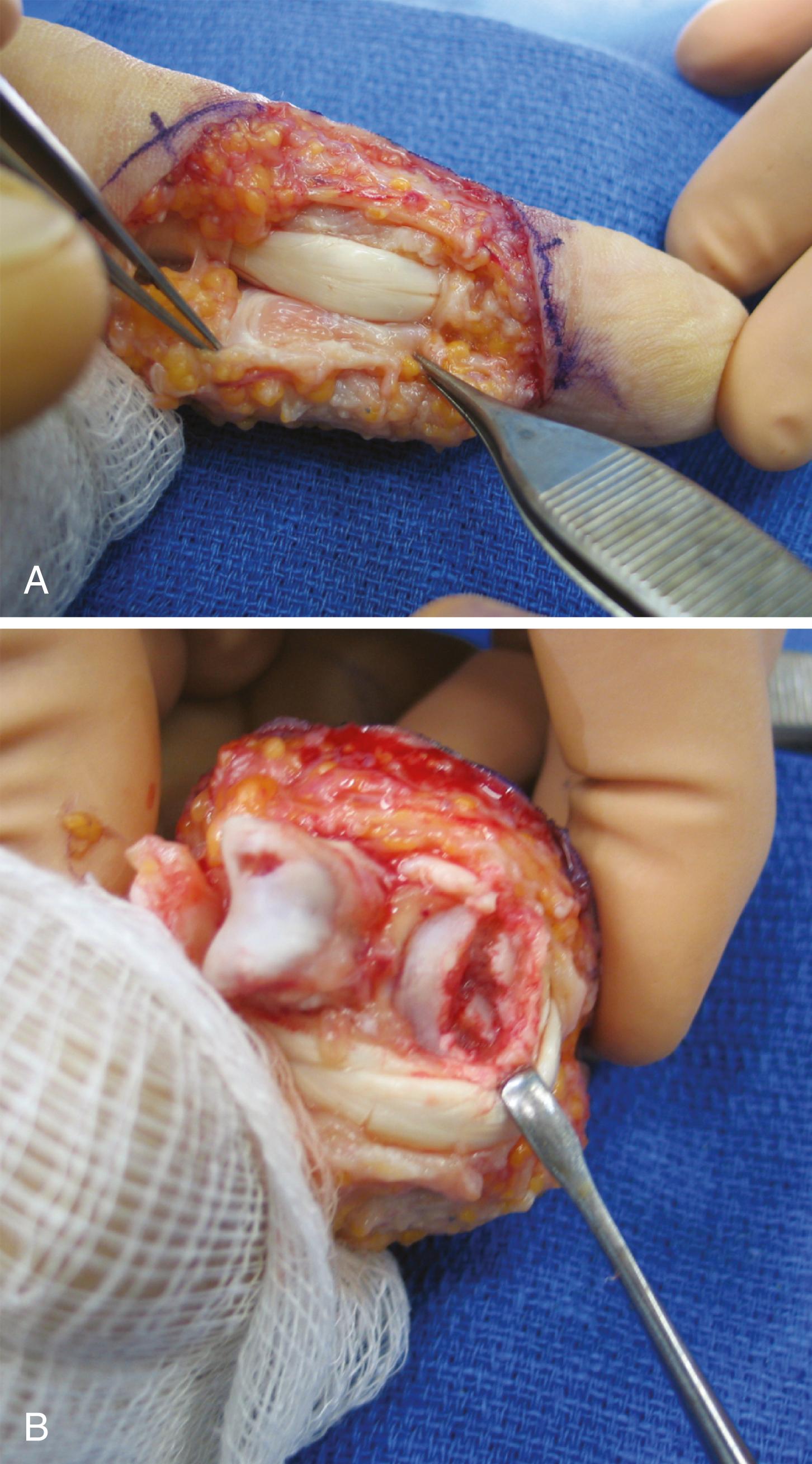
If the volar fragment(s) are large, the joint is reduced and the fragment held with two to three 1.0- to 1.5-mm lag screws, the goal being an anatomic, stable reduction. In hard bone, the small screw head(s) are countersunk to minimize flexor sheath irritation, and care is taken to avoid screw tips extending beyond the dorsal cortex where they will irritate the extensor mechanism. Release of the collateral ligament attachments to the fragment greatly improves visualization and eases manipulation. When there is comminution of the volar fragment(s), a 1.3-mm volar buttress plate may be applied ( Fig. 8.15A and B). The flexor digitorum superficialis slips insert radially and ulnarly, so a centrally placed plate is well tolerated. Protected early motion is the goal.
Have a backup plan (i.e., hemihamate autograft or dynamic skeletal fixation) because comminution is often worse than demonstrated on preoperative radiographs.
The technique is best for a single, large fragment pattern, but smaller implant systems with 1.0- to 1.5-mm screws and 1.3-mm plates can render stable reduction with other more comminuted fracture types.
Sharp dissection with meticulous handling of soft tissues cannot be overemphasized.
Inspect the dorsal surface carefully to make sure it is anatomic and elevate impacted fragments, adding bone graft as needed.
After fixation, check a lateral in flexion and extension to make sure the joint maintains a congruent reduction throughout the full range of motion and does not subluxate particularly in extension.
Construct must be sufficiently stable to permit early motion. If unstable, consider adding an additional Kirschner wire dynamic external fixator to maintain stability during early motion.
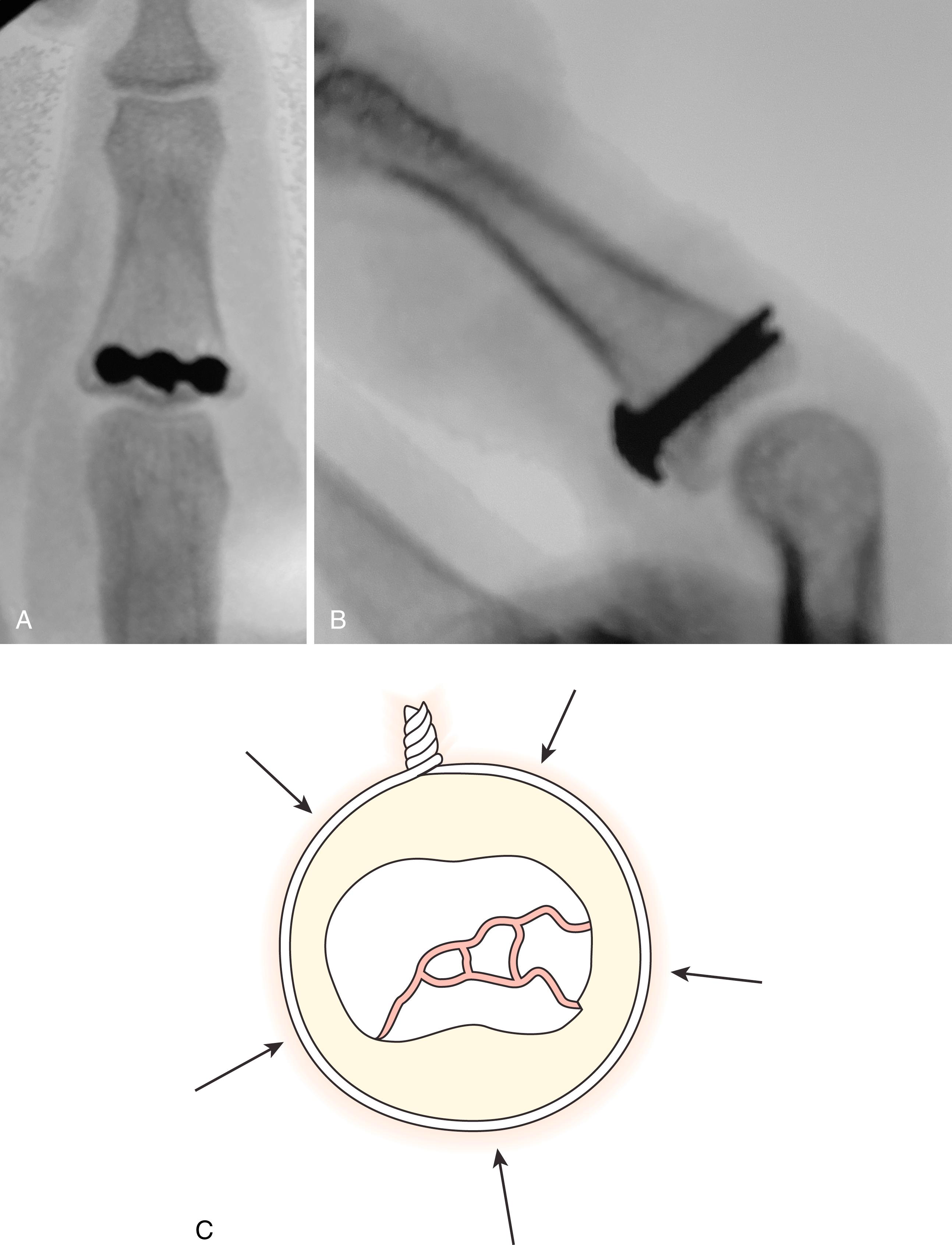
If stability is achieved, immediate, active range of motion of the joint is encouraged. Between exercises the digit is immobilized in a gutter splint with the PIP joint maintained in full extension (as long as there is no joint subluxation) to prevent flexion contracture. Passive range of motion and dynamic splints are started based on the surgeon’s assessment of the integrity of the repair.
Four recent case series of 54 patients who had undergone volar miniscrew ORIF demonstrated PIP flexion arc of 55 to 115 degrees (average, 80 degrees) with an average 10-degree flexion contracture. Strength averaged 85% of the uninjured side.
For pilon or comminuted fractures with fragments too small for individual screw fixation, one may consider elevation and grafting of depressed fragments followed by cerclage wiring to prevent widening of the articular surface. This technique is most appropriate for the rare case where there is minimal joint subluxation but significant comminution of the joint surface. In a series of 12 patients, Weiss demonstrated an average range of motion of 89 degrees with an 8-degree extensor lag.
A volar chevron incision is made from the MP joint to the DIP joint. The neurovascular bundles are mobilized away from the flexor sheath to avoid traction injury during the shotgun approach (as described previously). A dental pick is used to align and elevate fragments. Bone grafting of impacted subchondral bone is done as needed. Sharp dissection is used to clear the proximal 1 to 2 mm of the middle phalanx from the periosteum to allow the wire to be seated. A loop of 24-gauge wire is formed and twisted on itself, placed around the bone, and gently tightened (see Fig. 8.15C ). The joint is gently distracted and reduced. The joint is placed through a range of motion to assess congruency and stability. A “V”-shaped wedge is removed from the volar plate and the lateral edges are repaired ( Fig. 8.16 ). This prevents hyperextension but eliminates bulk under the flexor apparatus. This also decreases tension on the repair, allowing for immediate full or nearly full extension in therapy. This method of addressing the volar plate may also be used in cases of ORIF with screws and/or plate constructs.
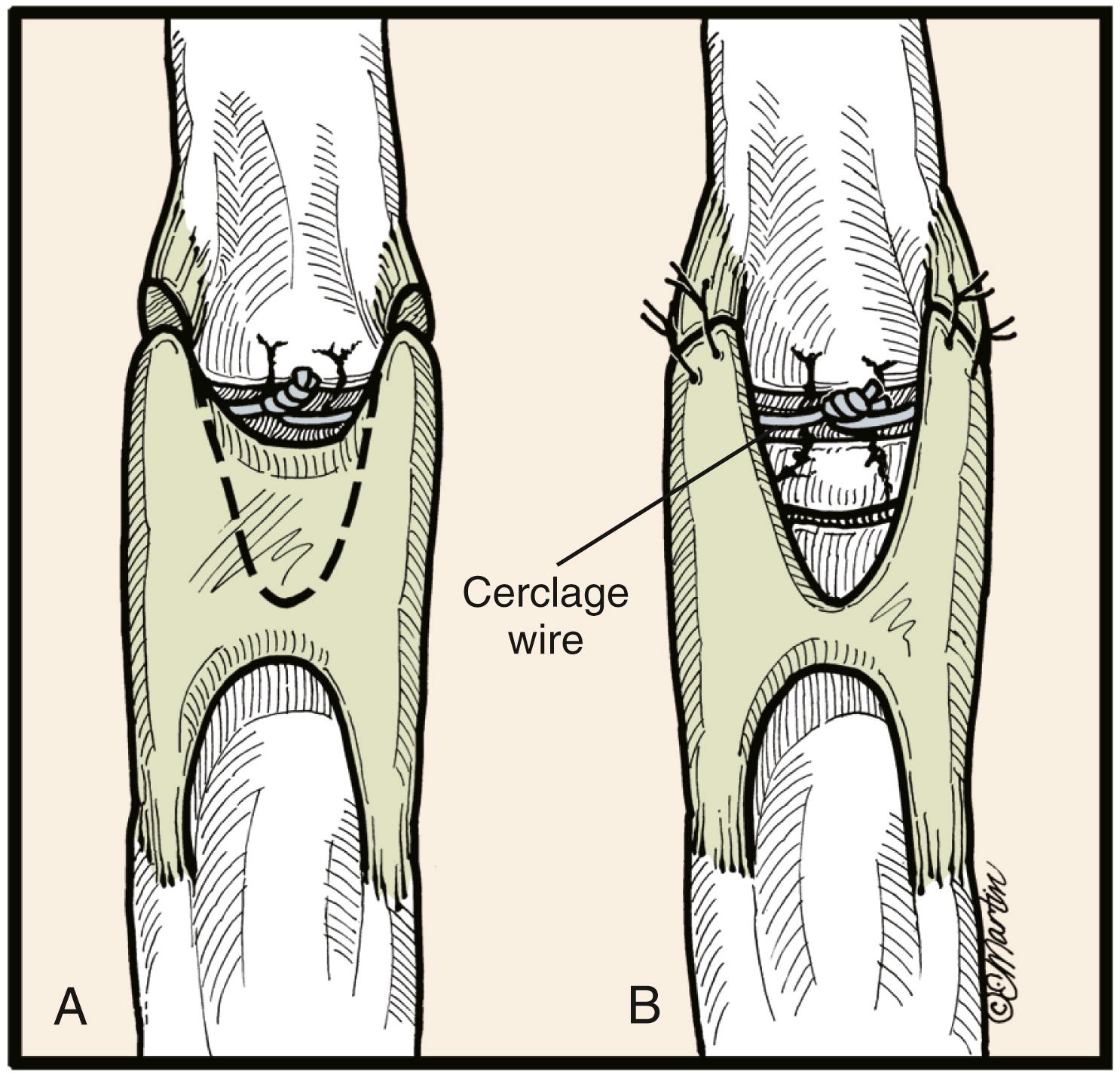
Therapy is initiated after 2 to 4 days to allow for edema control. Active and passive motion is allowed with interval gutter splinting. Static or dynamic splinting is added at 2 weeks if motion is slow to progress.
Multiple authors have reported on the technique and efficacy of using the distal aspect of the fibrocartilaginous volar plate to resurface the comminuted volar articular surface of the middle phalanx, especially when other techniques are not feasible. , As a variation on the theme of volar plate arthroplasty, Wiley proposed excision of the fragments and insertion of a slip of flexor superficialis tendon into the defect to reduce the displacement by active tenodesis. The irregularity of the articular surface was not specifically corrected in these series. Volar plate arthroplasty is most likely to succeed in cases with less than 40% volar articular involvement or when there is minimal impaction of the volar rim, in which case thickness of the interposed volar plate may correct for the buttress effect that has been lost. It is not recommended when volar articular involvement exceeds 40% of the joint surface.
The PIP joint is exposed using a radially based flap through a chevron-shaped incision with its apex at the ulnar midaxial point. The flexor sheath is excised between the A2 and A4 pulleys, and the flexor tendons are atraumatically retracted with a Penrose drain. The articular surfaces are very difficult to assess with the joint reduced. The volar plate is released distally off the base of the middle phalanx for later interposition. Hyperextension of the joint will usually expose the distal edge of the fracture fragment, facilitating entrance into the joint. A shotgun approach as described above is utilized to gain access to the joint and to release any preexisting joint contracture.
Congruous reduction may not be possible if the fracture fragments are markedly comminuted or impacted. Loose bone fragments and the segment attached to the volar plate are excised and saved for potential bone graft material. The defect in the volar rim of the middle phalanx is shaped into a transverse groove perpendicular to the long axis of the phalanx. Deeply impacted dorsal fragments should be left undisturbed to serve as a buttress for the volar plate. The interval between the volar plate and both collateral ligaments is incised, and the fibrocartilaginous plate is mobilized if necessary to allow its advancement 4 to 6 mm distally into the defect in the base of the middle phalanx. The more recent the injury, the more easily the plate will advance. In late cases, it is usually necessary to partially release ( Fig. 8.17 ) the proximal checkrein ligaments to gain sufficient length for advancement.
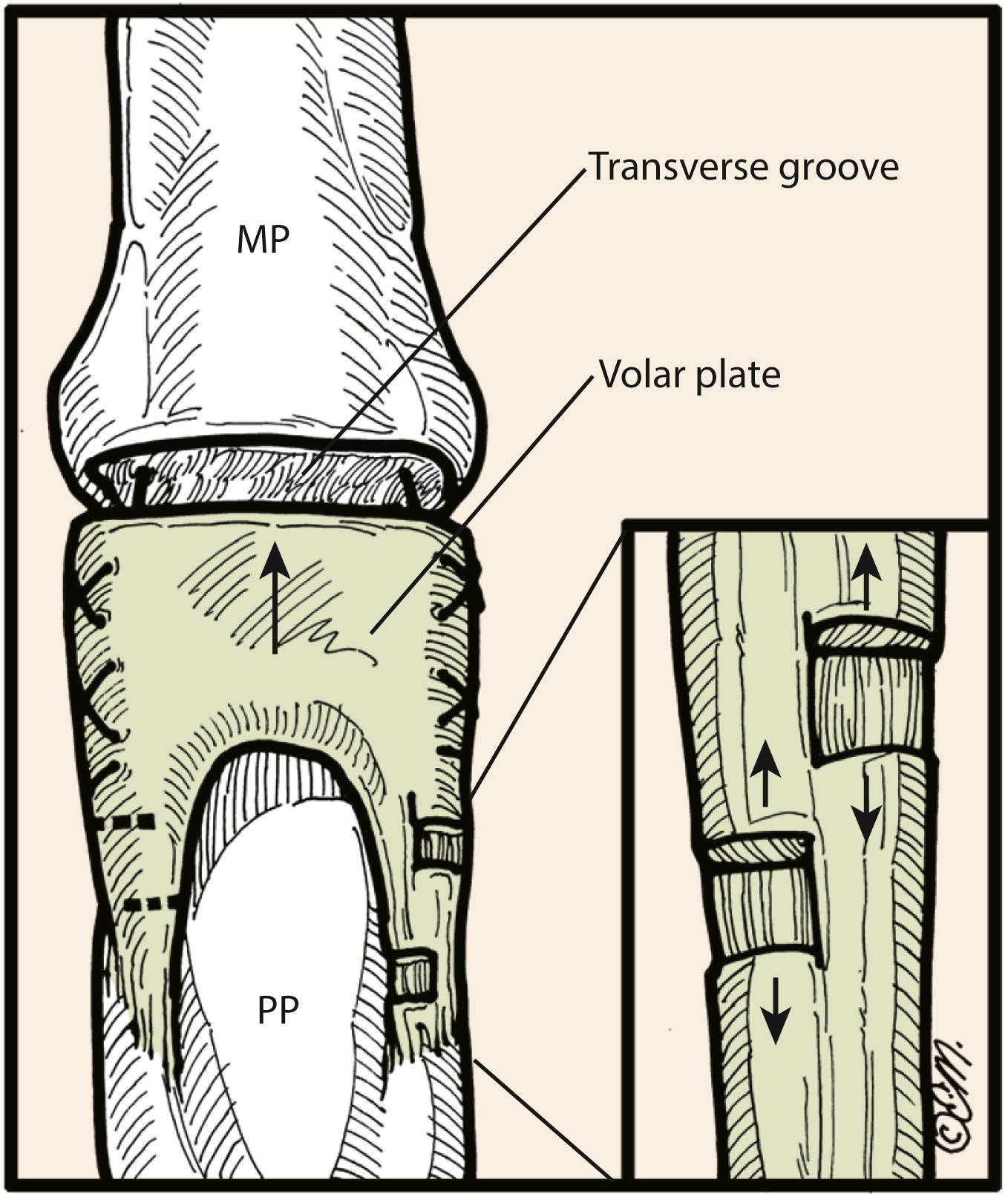
The volar plate is advanced into the middle phalangeal defect by means of a pull-out wire or suture, which spirals along the radial and ulnar margins of the volar plate and is passed through drill holes in the radial and ulnar margins of the middle phalangeal defect ( Fig. 8.18 ). The holes are made by drilling a Keith needle from volar to dorsal, and the needles are threaded with the suture and pulled out dorsally. These holes should be as proximal as possible (immediately deep to the remaining dorsal subchondral plate) to draw the plate against the edge of the remaining articular cartilage. They should exit the dorsum of the middle phalanx more centrally through the triangular ligament of the extensor mechanism to avoid binding down the lateral bands. The DIP joint should be flexed 30 degrees as the suture is passed through the extensor mechanism to avoid tethering the terminal tendon. Traction on the sutures emerging from the dorsum of the middle phalanx facilitates reduction of the joint as the plate is advanced into the defect.
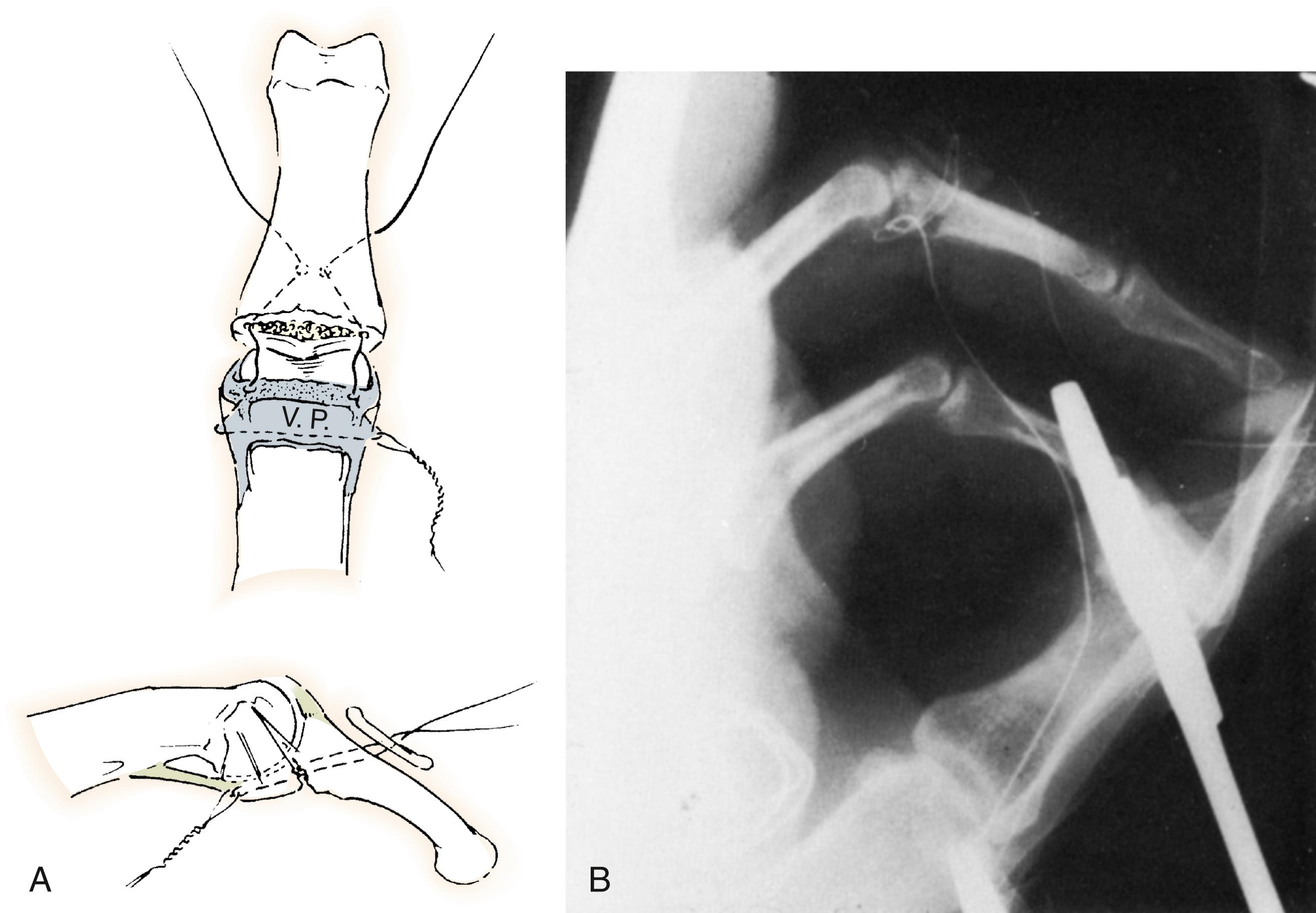
Lateral radiographs are obtained before tying the sutures to confirm that a congruous reduction throughout a full arc of motion has been achieved. Maintenance of the reduction with articular gliding through the flexion arc (as opposed to hinging on the dorsal articular surface) must be documented. This is particularly true in chronic fracture-dislocations with dorsal adhesions. If hinging is present, additional release is necessary, usually of the dorsal capsule, which may have become scarred and inelastic over time. Once a congruous reduction and arc of motion are ensured, the pull-out sutures are tied over a button dorsally. Alternatively, a small incision can be made dorsally and sutures tied down just distal to the central slip insertion, taking care to avoid the lateral bands. A secondary suture is placed between each margin of the volar plate and its adjacent remaining collateral ligament remnant. This reestablishes three-dimensional stability and ensures broad coverage of the condyles and phalangeal base. If there is too much laxity in the volar plate with the joint reduced, additional tightening sutures may be placed to further imbricate the sides of the volar plate to the accessory collateral ligaments, although this is rarely necessary. An oblique Kirschner wire is used to maintain the reduced joint in 20 to 30 degrees of flexion for 3 weeks. In large defects, bone graft should be applied deep to the advanced volar plate to reduce the chance for recurrent subluxation.
DIP joint motion is started immediately. Three weeks after surgery, the Kirschner wire is removed, and active, unlimited flexion of the PIP joint is begun using a dorsal extension block splint. Unrestricted active extension is permitted at 4 weeks after surgery, and dynamic extension splinting is begun if full active extension is not regained by 5 weeks after surgery. Unlimited sports activities are allowed at 8 weeks with buddy taping, and buddy taping is continued for 4 to 6 months. Swelling may persist for several months, and it may take up to 6 to 8 months to achieve final range of motion.
Determine whether the remaining dorsal articular surface is anatomic or impacted.
Appropriate for unstable fracture-dislocations too comminuted and unsuitable for ORIF; indicated for fractures in which 40% or less of the articular surface is involved and in occasional cases with articular depression of more than 40% but less than 1.5 to 2 mm; not advised for volar fracture involvement exceeding 40% to 50%.
Use volar approach with chevron incision.
Excise comminuted fragments and elevate dorsal, impacted articular surface.
Bone graft larger defects distal to interposed volar plate.
Place holes for pull-out sutures as proximal as possible and avoid lateral bands dorsally.
Establish ideal length of volar plate with joint reduced.
Reduce joint, tie sutures with DIP flexed, and document congruency radiographically in flexion and extension.
Pin in 20 to 30 degrees of flexion for 3 weeks only.
Overlooking stable but impacted dorsal articular surface.
Impaling lateral bands with pull-out sutures.
Failing to spread volar plate broadly across condyles.
Failing to identify hinged versus gliding flexion via dorsal adhesions.
Failure is likely in fracture-dislocations with greater than 40% articular involvement.
Immobilize joint with Kirschner wire and splint for 3 weeks.
Remove pin at 3 weeks and obtain radiographs after pin removal.
Use extension block flexion for 1 to 3 weeks and then unlimited extension.
Use a dynamic extension splint at 5 to 6 weeks as needed.
Eaton and Malerich reported on 24 patients who underwent volar plate arthroplasty for both acute and chronic PIP fracture-dislocations, with a 10-year average follow-up. The seven procedures performed within 6 weeks of injury attained an average of 95 degrees of motion and a 6-degree flexion contracture. In contrast, the 17 patients with chronic injuries (>6 weeks after injury) achieved 78 degrees of motion and 12 degrees of contracture. Only 3 patients reported pain, and only with strenuous use. Other reports have also noted good results in most patients. , My own experience has not been as optimistic. The procedure is more appropriate for patients with volar articular involvement of less than 40% to 50%, and it has failed when I have used it for joints with greater involvement.
Become a Clinical Tree membership for Full access and enjoy Unlimited articles
If you are a member. Log in here